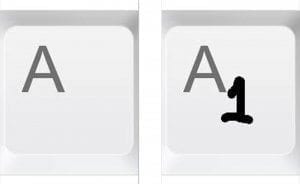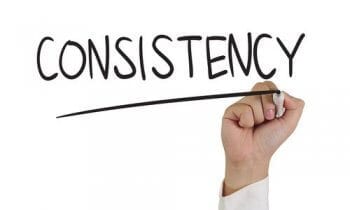Why are You not Consistent? Or Are You?
I always ask a new client what they want to accomplish within any Coaching Program. The Number 1 answer is almost always, “I want to be more consistent.” My reply is almost always, “Why are you not consistent?” or “What is your definition of consistent?” As I inform all new clientele midway through this conversation, you’re more consistent now than you will be after our session. Why?
Think about this, why are you not consistent? And are you making a judgement about consistency purely on a small portion of ball flight vs. the entire shot? But more importantly, what standard are you comparing your inconsistent performance to?
Why are You Not Consistent? The Answer is About Feeling, Not Seeing
You’re more consistent now then you are after instruction because instruction provides new feelings and ideals of how you can perform. Efficiency and Consistency are 2 completely different ideals that coexist within your golf game. They stay different ideals until you decide to commit to a long-term Improvement Plan. All instruction introduces new movements your brain and body must feel differently than the swing you produce right now. This difference in the brain is so minute, it sometimes confuses the passage way of nerve/impulse communication. Why? Because you’re still holding a golf club and making a swing.
A simple analogy I use often is a button in your brain that is pressed each and every time you hold a golf club and make a swing. Let’s call that button, “Button A.” When you are attempting to improve your swing, for more consistency, you are in fact creating a button in the brain called “Button A1” Why? Again, because you’re still holding a golf club and making a swing. Until such time that the small minuscule differences that define Button A from Button A1 are clearly defined by the brain, your brain stays confused. Whether you know it or not, your brain in this confused state asks you the question each time you want to make a swing, “Hey, do you want me to press Button A or Button A1 when I make this swing?” Does this question present the possibility of being consistent?
A Positive Way of Thinking About Consistency
So let’s rephrase your statement, using a more realistic response to set you up for success. The next time you are asked by your coach what you’d like to accomplish with instruction, tell your coach, “My trending miss shot is ______ (fill in the blank). I’d like to improve that aspect of my game.”
By rephrasing your response in a detailed and proactive way, you’re already one step ahead of your learning curve. By definitely identifying a trend that ultimately causes your higher scores, you create the formation of Button A1 in a way that suggests it’s different. It also places your brain into a learning mode, open to suggestions of improvement. In addition, there’s no measurement against a vague standard of what “consistency” means. You’re clearly telling yourself there will be Improvement compared to what I am doing now.
Why Are You Not Consistent? Answer #2 is All About Your Set-Up Consistency
So let’s get practical now. Why are you not consistent? Simple. You’re not consistent with your pre-shot and post-shot routines. This may sound too simple. But this is how each button is created, from the beginning. Let’s explore this so you understand why.
Are you repeating the same routine each and every shot? Are you standing behind the ball on a direct line to your target each time you prepare for a shot? Are you the proper distance away from the ball top actually see a true target line? Do you have a repeatable process that insures you are set up consistently each time you prepare to make犀利士
a swing? And do you provide yourself an opportunity to evaluate each shot, objectively, after each swing is complete?
If you answered “no” to any of the questions I posed, then you are and will remain inconsistent with your swing until you do something about the consistency of your pre-shot and post-shot routines.
How do You Create a Consistent Pre-Shot and Post-Shot Routine?
Why are you not consistent? Let’s go back to the original theme of this post and tie it in with how you can create your best chance to make “in-swing” improvements. Setting up Button A1 correctly requires you being consistent before making improvements, a repeatable and predictable pre-shot routine. How can you become consistent making swings if you inconsistently prepare to make swings? Here are some suggestions to the questions asked above:
- Are You Repeating the Same Routine for each Shot? – No matter what you do, start becoming aware of what you do and in the order you do it. Take notes if you have to and find the routine that produces a more consistent shot pattern;
- Are You Standing on the Target Line? – My experience shows most golfers stand to either side of the target line, not directly on it. By standing to either side, you’ll not see the target line correctly and probably aim to the opposite side of the target line of which you saw. You’re also using one eye in this case to aim instead of both, providing a disservice to your brain and an inaccurate image of what the shot should look like;
- Are You the Proper Distance Away from the Ball? – Seeing with 2 eyes to see the target line requires more distance from the ball than you’re probably allowing. Over the years, I normally see my clientele stand only a couple feet away from the ball while envisioning a target line. Back away to 10 feet and they’re amazed at the clarity they gain seeing the target line. Be sure you are providing enough distance between you and the golf ball to see the true target line;
- Do You Repeat a Process that Insures Consistency? – When asked, most clients tell me they have no clue in which order they create their set-up position. No wonder they’re inconsistent. Humans are creatures of habit and similar to learning your telephone number, your brain likes logical and repeatable sequences. Why not do the same for your golf pre-shot routine? I always recommend setting up the leading edge of your club to the target line first. Doing so carries forward you looking at the target line prior to addressing the ball. You can follow that step with others steps, so long as the steps repeat in the same order to insure consistency;
- Do You Evaluate Each Shot? – Most golfers evaluations end immediately after the first 50 yards of ball flight and then turn into a negative rant about how bad the shot is. Stop killing yourself over only part of the shot. There is a logical 2+2=4 equation going on in your brain. You can not become consistent if you shut the equation off before it ends in a sum. The first “2” is how you set up. The second “2” is how you swing. Which equals the “4”, how the ball flies, rolls, and comes to a stop. If you see all 3 items of ball flight, roll, and stop, you’ve now completed the equation and are better prepared to evaluate the shot in its entirety.
Being consistent starts with understanding the definition of the word. Chances are you the reason why you are not consistent is because you never took that definition to heart. And being consistent also requires you to perform in a predictable fashion that repeats, no matter what the shot. Another reason why you are not consistent.
Conclusion – Why You Are Not Consistent? Start from the Beginning
Before starting a program that requires you to change swing habits, start an improvement process that allows for more consistent set-up and evaluation first. You’ll be surprised how much more “consistent” you’ll become doing so. You’ll also discover that the real items to improve in your swing, not the ones you believe are causing your “inconsistency.”








